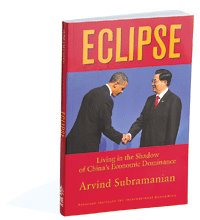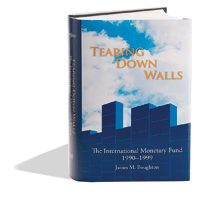Book Reviews
Finance & Development, December 2011, Vol. 48, No. 4
A Stroll in the Past
Sylvia Nasar
Grand Pursuit
The Story of Economic Genius
Simon & Schuster, New York, 2011, 558 pp., $35 (cloth).

In A Beautiful Mind, the biography of Nobel Prize–winning economist John Nash, Sylvia Nasar achieved a brilliant integration of life and thought, as well as offering an absorbing study of the fragile nature of genius. Grand Pursuit, in which intellectual history is told through group biography, is less successful. Nasar tells the story of a dozen or so economic “geniuses” ranging from Karl Marx to Paul Samuelson and Amartya Sen. She offers a “life and times” for each and an accessible and accurate account of their main ideas.
But the canvas is too large, and the pace too breathless, for proper integration of the main elements. The links between lives, times, and ideas sometimes seem artificial, and Nasar eschews the use of generalizing summaries, which might have made sense of them. Some connections are not made at all: for example, there is no mention of Knut Wicksell and the Swedish contribution to modern economics. The result has a flavor of intellectual and historical tourism. It is a most enjoyable read, but the formula, so successful in the earlier book, does not quite come off.
The grand pursuit of the title was, it turns out, inspired by the “idea that humanity could turn the tables on economic necessity, mastering rather than being enslaved by material circumstances.” Economics, as Nasar tells it, was invented largely to free people from poverty. The do-gooder element was there from the start but, in a secular age, it required a scientific, rather than theological, basis. (Nasar might have drawn attention to the number of early economists profiled in this volume, including Irving Fisher, John Maynard Keynes, Alfred Marshall, and Joan Robinson, who came from clerical backgrounds.)
Nasar’s implicit claim is that the advance of economics led to improvement in material conditions. The divisions in economics that most interest her are between those who believed in progress through laissez-faire and those who believed in progress through government action. Presumably, it was as a representative of the latter tendency that Beatrice Webb, who was not an economist even in the elastic 19th century sense of the term, merits inclusion in the book.
A central feature of the epoch covered by Nasar is the business cycle, and the doctrines of her great economists can almost be read as their responses to these violent oscillations in economic activity. Joseph Schumpeter—in some ways the idiosyncratic hero of this book—believed that slumps were a necessary part of progress and should be endured. Friedrich Hayek believed they were unnecessary but should nevertheless be endured. Keynes believed they were both unnecessary and should not be endured.
In this classification, Keynes’s views seem closest to those of Fisher and Milton Friedman, who believed appropriate monetary policy could both prevent and remedy slumps. But Keynes thought monetary policy was not enough: fiscal policy was necessary as well.
If Keynes, Fisher, and Friedman have one kind of family resemblance, so do Keynes and Hayek, in their resistance to the mathematization of economics. This stemmed from their rejection of the “perfect information” postulate. Schumpeter is an anomaly in this respect, as in most others: his idea of the “heroic entrepreneur” as the agent of progress comes close to Keynes’s notion of “animal spirits” as the driving engine of capitalism. Yet he never gave up hope of making economics as hard a science as physics, and spent the last day of his life working on the math he had never mastered.
Nasar’s optimism is apparently untroubled by the Great Recession and its aftermath. The financial crisis exposed our imagined mastery of risk as hubris—shared by politicians, bankers, and economists alike. But the mistaken thinking that led to the crisis has its roots in a development celebrated in Grand Pursuit. One of Nasar’s chosen geniuses is Paul Samuelson, whose Foundations of Economic Analysis laid the basis for the model-building approach that has dominated economics for the past 50 years.
In a telling example of the privileging of biographical over theoretical details, Nasar dismisses the “fear that mathematics would cause other languages to wither” by pointing out Samuelson’s “verbal virtuosity” and John von Neumann’s ability to “quote verbatim from Dickens.” But she must know that this is not the point.
Robert Skidelsky
Emeritus Professor of Political Economy,
University of Warwick
In the Heat of the Sun
Arvind Subramanian
Eclipse
Living in the Shadow of China’s Economic Dominance
Peterson Institute for International Economics,
Washington, 2011, 216 pp., $21.95 (paper).
 The main message of this impressive little book is that “Chinese economic dominance is more imminent and more broad-based—encompassing output, trade and currency—than is currently recognized.” The author asks whether China will abandon mercantilism, champion free trade, and turn the renminbi into a freely convertible reserve currency—all in its own self-interest—and touts multilateralism as the best way for the world, including the United States, to manage the inevitable tensions between an increasingly powerful China and the rest of us. He favors the World Trade Organization over the IMF when it comes to keeping China’s economic power in check and channeling it constructively and believes it is time to drop the Doha Round and start a “China Round.” Similar to the Tokyo Round of 1973–79, when Japan’s economy was front and center, China Round negotiations would firmly anchor China in the multilateral system.
The main message of this impressive little book is that “Chinese economic dominance is more imminent and more broad-based—encompassing output, trade and currency—than is currently recognized.” The author asks whether China will abandon mercantilism, champion free trade, and turn the renminbi into a freely convertible reserve currency—all in its own self-interest—and touts multilateralism as the best way for the world, including the United States, to manage the inevitable tensions between an increasingly powerful China and the rest of us. He favors the World Trade Organization over the IMF when it comes to keeping China’s economic power in check and channeling it constructively and believes it is time to drop the Doha Round and start a “China Round.” Similar to the Tokyo Round of 1973–79, when Japan’s economy was front and center, China Round negotiations would firmly anchor China in the multilateral system.
Written by an economist, but intended for a broader audience, the book is fact based and technical in nature, complete with quantitative sensitivity analysis. It is not an in-depth assessment of what China might look like as a dominant economic power or of the domestic impediments to such dominance. As China specialists know, those hurdles are numerous and significant. In a future edition of this book, the author might do well to explore how China’s global economic power in 2030 is likely to differ from that of the United States in the 1970s and of the United Kingdom a century earlier. Unless China gets serious about democracy, however, it will never be an attractive model for the rest of the world and will have scant soft power. The book deals little with the challenges between China and the rest of the world, especially the United States as the current leading power. Nor does it address the dangers if China does not open up economically and politically or if the United States fails to make necessary domestic economic and fiscal adjustments in a timely manner, which seems increasingly likely.
I have questions about the book’s methodology and assumptions, but agree with most of its conclusions and believe that its central message must be taken seriously. In some respects China is already a dominant economic power. The rapid growth rate of its economy means China influences global demand and commodity markets more than the United States, whose GDP at market exchange rates is still well over twice that of China. When it comes to measuring the international economic influence of large economies, such as the United States and China, GDP size (even adjusted for purchasing power parity) may matter less than the rate of growth. Another methodological question concerns the measurement of trade as a power-determining factor. China’s trade is indeed enormous—and may well grow to 15 percent of the world’s total by 2030 (compared with 9.8 percent in 2010), as the author projects. But the share of China’s processing trade (which generates little domestic value added) in total trade is likely to remain far higher than the world average over the next 20 years. Should processing trade be given the same weight as standard trade in calculating global power? I think not.
An interesting and controversial assertion is the prediction that China will advance its self-interest by ending domestic financial repression (artificially low interest rates and an undervalued exchange rate) and championing global free trade. The author makes much of China’s recent efforts to promote internationalization of its currency, which he believes portends removal of all capital controls and the debut of the renminbi as a reserve currency. The logic is clear, but is it realistic? I doubt it. The domestic political implications of the renminbi as a reserve currency are serious. The system of financial repression is an integral part of China’s political system and of Chinese Communist Party control and is unlikely to be abandoned in the foreseeable future. Let’s hope the author is right and I am wrong: ending financial repression and a freely convertible renminbi that could serve as a global reserve currency are in China’s (and the world’s) long-term interest.
Pieter Bottelier
Senior Adjunct Professor, School for Advanced International Studies,
Johns Hopkins University, and author of many articles on China
The Stormy Decade
James Boughton
Tearing Down Walls
The International Monetary Fund 1990–1999
International Monetary Fund,
Washington, 2012, 992 pp., $90 (cloth).

In this volume, the fifth in a series, James Boughton presents a scholarly, comprehensive, and sometimes surprising history of the IMF in the 1990s. Tearing Down Walls is a worthy addition to the series in question, which also includes Boughton’s Silent Revolution on the period 1979–89.
For specialist researchers, Tearing Down Walls will be an invaluable guide to IMF documents. For nonspecialists seeking a broad overview of the IMF, it will be a useful introduction. And for IMF staff seeking to understand the evolution of their own institution, it will be a key resource.
But multiple audiences make for tension between the need to be encyclopedic and the desire to highlight important themes. It may be intrinsic to this kind of project that the encyclopedic tendency frequently prevails. Boughton’s approach to describing the IMF’s activities in eastern Europe and the former Soviet Union, for example, is to provide capsule histories of each and every former Soviet bloc economy. The result does not always make for easy reading.
The author bases his account mainly on the IMF’s archives, to which he had unfettered access, and on participant interviews. Still, one wonders how much the account is colored not just by how the events in question looked to Boughton’s sources, but also by how those sources now wish those events to be seen.
Michel Camdessus, the IMF’s managing director at the time, comes through in these pages as energetic, ambitious, and willing to put his reputation on the line when the stakes are high. Camdessus’s indefatigable first deputy managing director, Stanley Fischer, emerges as the key player in crisis management.
Yet, aside from these figures, personalities play a surprisingly small role in the story. Boughton may be right to de-emphasize them insofar as bureaucratic politics constrain individual room for maneuver in a large organization like the IMF. But if so the author might have said more about those bureaucratic machinations.
We hear relatively little about the struggles between “area” departments, which tend to be relatively sympathetic to the countries they oversee, and “functional” departments such as those responsible for monetary and fiscal policies, which tend to be more critical. Certain departments within the IMF are notorious for being more or less open to new ideas; one functional department during the period in question was informally referred to, less than fondly, as the thought police. Again, this is something about which one would wish to learn more.
The title Tearing Down Walls evokes the fall of the Berlin Wall and the transition from a planned to a market economy in the former Soviet bloc. It alludes to the IMF’s efforts to become more transparent—to tear down the walls separating the institution from the outside world. And it refers to the process of globalization, in which the IMF’s role remains controversial.
A first section covers the transition to the market in eastern Europe and the former Soviet Union. Boughton portrays the IMF as the appropriate institution to have spearheaded this effort. The Fund specializes in helping countries correct macroeconomic and structural imbalances, and the former Soviet bloc economies had macroeconomic and structural imbalances with a vengeance.
Yet the IMF was not exactly generously staffed with economists knowledgeable about the former Soviet Union—countries that were not members before the Wall fell. The fundamental problem for those countries was less restoring macroeconomic balance than it was building markets where none existed and the management of large-scale privatizations. The IMF had no comparative advantage when it came to these tasks. Boughton himself brings out, for example, how the Fund was frequently at sea over privatization.
The book turns next to the Mexican, Russian, and Asian crises. Although these episodes have been extensively analyzed, Boughton offers a few revelations. We are told, for example, how the IMF first learned of the peso’s impending devaluation not from the Mexican government but through an offhand remark by a high-ranking U.S. official. We learn that the reason the IMF did not do more to discourage Russia from defaulting was because of a telephonic miscommunication between Camdessus, on summer vacation in Bayonne, France, and the Fund’s man in Moscow, John Odling-Smee.
At points the drama is compelling. One cannot help but be impressed by the number of emergency phone calls at 2:00 a.m., and by how frantically IMF officials shuttled to Moscow and Jakarta to keep the world economy from falling off a cliff.
Boughton describes just how close the world came in 1995, in 1997, and again in 1998 to a “Lehman Brothers moment.” In retrospect it is clear that, already in the 1990s, something was dreadfully wrong with a global financial system that was so vulnerable to collapse. One wonders why the IMF did not do more at the time to rectify the problem.
Finally, it is striking which topics make only a cameo appearance: China, India, global imbalances, the international role of the dollar, the advent of the euro. No doubt these will be central issues in the next volume in the series. But that they are not more prominent here is revealing. It is revealing of the fact that the IMF, while a learning institution, is also a reactive institution. Its tendency is to react to the last problem rather than to anticipate the next one.
Barry Eichengreen
George C. Pardee and Helen N. Pardee Professor of Economics and
Political Science at the University of California, Berkeley,
and former IMF Senior Policy Advisor (1997–98)


